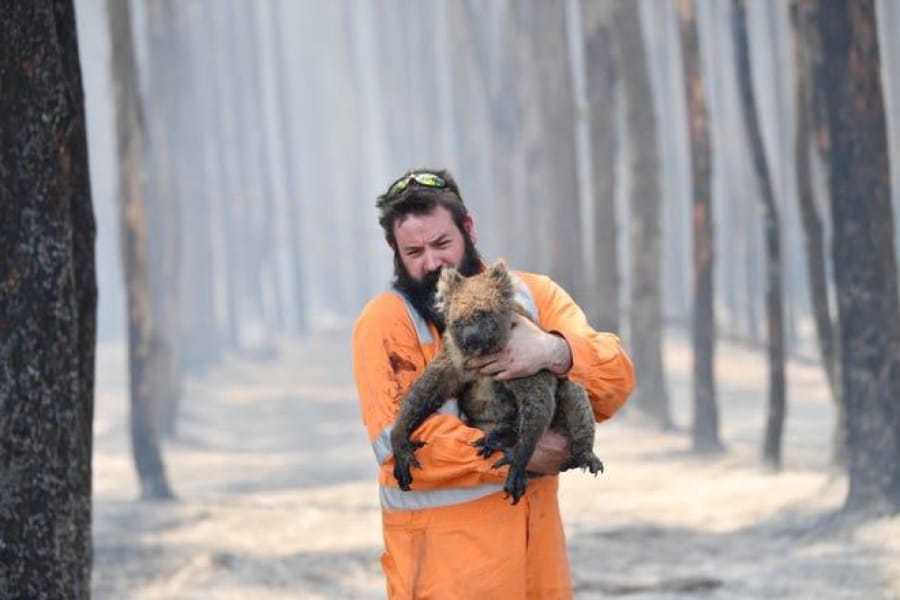SAN DIEGO — Researchers backed by the San Diego Zoo are scrambling to save koalas threatened by the rampaging brush fires in Australia.
Officials said a team working in the Blue Mountains — home to the most genetically diverse population of koalas in the world — was able to find and capture a dozen of the marsupials as the flames approached last month and moved them to a zoo in Sydney for safekeeping.
They’ll be returning to the area to search for injured animals and assess the habitat damage. San Diego Zoo Global officials said they are “committing resources to ensure that the population is recovered.” The cost of that effort, which is expected to take years, is not known.
Since the Australian fire season began in September, dozens of blazes have broken out, scorching more than 12 million acres. At least 26 people have died and more than 2,000 homes have been destroyed. By some estimates, hundreds of millions of animals have perished or been affected.
In the Blue Mountains, located in New South Wales, about 2.5 million acres were burned. The region was listed as a World Heritage site in 2000 because of its “significant natural resources,” including 96 species of eucalyptus tree, which are both home and food for koalas.
Science for Wildlife, a Sydney-based nonprofit, has been studying the koalas in the Blue Mountains since 2014. Kellie Leigh, the executive director, has also been a researcher with San Diego Zoo Global since 2010. Her group sees the region as a potential refuge for koalas, which have seen their numbers drop from about 3 million to fewer than 300,000 across Australia. Before the fires, they were considered vulnerable to extinction, one step below endangered.
“We have been working in this area for many years now, tracking koalas to learn about them and to assess their population numbers,” Leigh said in a statement provided by the zoo. “The population of koalas in the Blue Mountains have high levels of genetic diversity. This makes this particular population very important for the survival of the species.”
Known for their tall trees and rugged terrain, the Blue Mountains make spotting koalas in the wild difficult. Researchers have tracked them with radio tags, which proved useful as the flames approached. Volunteers with Science for Wildlife located a dozen koalas during a mid-December rescue effort, and climbers went into the trees to capture them. They were taken to the Taronga Zoo until the fire threat passes.
Leigh said more search-and-rescue efforts are planned. Volunteers will also be putting out water for wildlife. The long-term goal is to “re-wild the koalas that were rescued and recover the population in the region,” she said.
San Diego Zoo Global has launched a fundraising campaign to support the recovery of wildlife in Australia at EndExtinction.org. It will join other long-term projects the organization has backed over the years to help California condors, pandas, northern white rhinos and other species.
The zoo’s ties to Australia go back almost a century. Businessman John D. Spreckels funded an animal-collecting trip there in 1925. Tom Faulconer, the zoo’s director, loaded a ship with 200 animals from North and Central America to trade for specimens from zoos in Sydney and Melbourne.
It got off to a bad start. In San Francisco, where the ship was docked, the crew wasn’t ready. They thought the request to make room for zoo animals was a joke. Cages were stowed wherever there was room on the deck, and several birds and small animals died from exposure. A 12-foot alligator escaped briefly. A spider monkey reached into a wildcat’s cage to grab a piece of meat and had its arm bitten off.
Faulconer collected kangaroos, Tasmanian devils, dingos and emus, but he was stymied in his effort to get koalas. The Australian government had a ban on their exportation. At the last minute, a truck raced up with two of them: Snugglepot and Cuddlepie, named after characters in a popular Australian children’s book.
They would become the first koalas ever displayed in the U.S., making them among the zoo’s earliest attention-drawing, attendance-driving celebrities. Its current collection of about 20 koalas is the largest outside Australia, with another 30 on loan to other zoos in the U.S. and Europe



